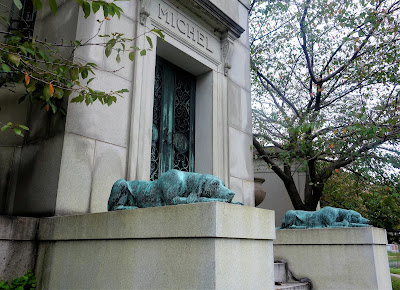Here's a few more photos from my autumn foray into Brooklyn's 478-acre Green-Wood Cemetery. Green-Wood was opened in 1830 and was part of the rural cemetery movement in America. The rural cemetery, for its founders and lot holders, represented the opposite of the quickly changing and disturbing urban industrial cities and towns. They were usually located outside of the city in the midst of nature to provide visitors with beauty and simplicity. They also represented permanence and security, as the deceased would rest there eternally, with no danger of being removed from an overcrowded city churchyard when the next body needed a burial space. Rural cemeteries also gave American communities a sense of their own history by tying them to the greater history of the United States as they recognized the achievements of their local pioneers and military veterans. These carefully planned landscapes were the very essence of the picturesque that nineteenth-century middle- and upper-class Americans strived to include in their lives. I only made it through a quarter of Green-Wood, but I managed to get, oh, 800 or so photos. I hope to go back in the spring for more!
 |
| Green-Wood's chapel, with mausoleums in the background. |
 |
| The front side... |
 |
| ...and the back side. |
 |
| Close-up of the bronze monument above. |
 |
| Lovely memorial to Clara Bartlett Gregory Catlin, wife of George Catlin, a talented painter known especially for his portraits of Native Americans. Some historians say Catlin had a second family in the West with a Native American woman while he was still married to Clara, who remained back East. It could be the reason that Clara's family buried George in the back of the Gregory family lot, NOT next to Clara. |
 |
| Love this, modeled somewhat after the haunting Angel of Grief that William Wetmore Story carved for his wife's gravesite in Rome. |
 |
| Close-up of the broken rose on Blanche's grave above. A broken flower means a life that never had a chance to fully bloom. Blanche died at age 15. |
 |
| Family plot for Horace Greeley and company. Greeley was the founder and editor of the New-York Tribune and ran unsuccessfully for president against U.S. Grant. |
 |
Green-Wood's chapel to the left, with the Manhattan skyline in the distance.
|
 |
| I usually don't take photos of modern graves, but this one reached out to me. |
 |
| I am sure it was just the light/time of day/NY smog/camera angle that caused this eerie glow. |
 |
| This and the next three photos are carvings on the main gate of Green-Wood, carved by John Moffitt, showing New Testament scenes of death and resurrection. The hope for resurrection was extremely important to 19th-century people, and most memorial symbols represent that very hope. |
 |
| This was so sad...the family lost three children over a period of time, and instead of three separate graves, they just added a new block for each new death. |
 |
| Absolutely amazing skill here... |
 |
| ...and here. The mourning veil really looks gauzy and thin. |
 |
| This is part of the monument to a sea captain. |
 |
| Beautiful poem on the grave of Lucy Midmer, who died a few weeks after giving birth to her son Henry, who only lived three days. |
 |
| Grave for a Native American woman who died in New York in 1844, aged 18. |
 |
| The other side of her tombstone. |
 |
| For Victorians, the death of a child, though heart-breaking, was also a triumph of innocence over the pain of life and the cruelness of death as the child went peacefully into an eternal sleep. |
 |
| I'm not sure, but I think this is Mary, crushing a snake under her foot, which is from the Book of Revelation. Mary is seen as a "slayer of dragons" (snakes), and was considered "the new Eve," saving the world from the devil. |
 |
| A snake again. I need to do some more research to discover who this represents. |
 |
| And finally, my favorite monument ever. The Matthews Monument won "Mortuary Monument of the Year" in 1868, as well it should have! John Matthews was known as "The Soda Fountain King," who created the process to make carbonation. This monument was carved by Karl Muller in marble, granite and terra cotta, and even though it has undergone a great deal of weathering, it is still marvelous. I must have one of my very own!!! |





















































































